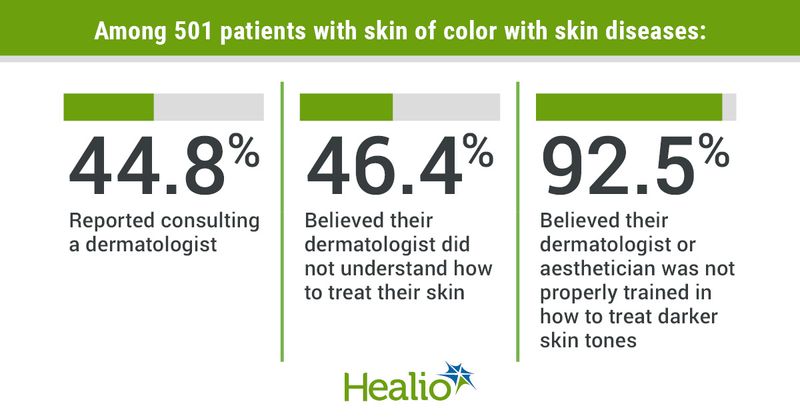Skin issues prompt emotional distress, hesitancy to seek care in people with skin of color
Key takeaways:
- 79.6% of respondents with skin of color experienced a bothersome skin condition.
- 92.5% believed their physician was not properly trained in how to treat darker skin tones.
An anonymous web-based survey found that respondents with skin of color reported emotional burdens from their skin diseases, as well as a belief that most dermatologists do not have the proper training to treat their skin type.
In August 2022, Beacon Science conducted the survey among self-selected consumers and included 56 questions addressing bothersome skin conditions, the conditions’ impact on mental health, dermatologic care access, thoughts on skincare products and the respondent’s opinion on a dermatologist’s ability to manage skin conditions in patients with skin of color, in addition to questions about demographics.

Of the 775 individuals that responded, 64.6% reported having skin of color, of whom 94.2% were women and 48.9% were aged 18 to 24 years.
Results from the survey showed that 79.6% of respondents experienced a bothersome skin condition. Additionally, 85.2% described their skin condition as moderately to extremely bothersome, and 57.4% reported their condition had an impact on their mental health.
The most common skin conditions that were reported as bothersome were discoloration/acne-related post-inflammatory pigmentation changes (69.5%), acne (58.5%) and ingrown hairs (48.1%), with 93.6% of respondents experiencing these conditions on their face.
When asked why they do not use available products for their skin conditions, an overwhelming majority stated price was an obstacle (72.2%) followed by side effects from the products (43.6%) and a lack of information on how the products work (39.3%). Additionally, 40.9% believed that their skin products do not address their skin needs.
While 44.8% reported consulting a dermatologist, 46.4% believed the dermatologist did not understand how to treat their skin. More specifically, almost all respondents (92.5%) thought their dermatologist or aesthetician was not properly trained in how to treat darker skin tones.
In regard to mental health, more than half of the respondents (67.4%) expressed that their skin condition affected their emotional well-being and reported feelings of self-consciousness (59.4%), low self-esteem (41.9%) and embarrassment (38.3%).
Many respondents reported editing their social media posts to cover their blemishes, receiving negative comments from others about their skin, isolating themselves, feeling depressed and experiencing bullying for their conditions.
“Overall, these survey results suggest there is a cyclical relationship between visible skin disease, psychosocial burden and beliefs about dermatologic care among [skin of color] consumers,” Martina M. Cartwright, PhD, of Beacon Science and The University of Arizona School of Nutrition and Wellness, and colleagues wrote. “Initiating therapeutic and educational strategies to interrupt this cycle would be a pivotal step forward in alleviating both the physical and psychological burden of skin disease in persons with [skin of color].”

